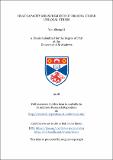Files in this item
Heat capacity measurements of Sr₂RuO₄ under uniaxial stress
Item metadata
| dc.contributor.advisor | Mackenzie, Andrew | |
| dc.contributor.author | Li, You-Sheng | |
| dc.coverage.spatial | ix, 171 p. | en_US |
| dc.date.accessioned | 2018-11-30T16:42:14Z | |
| dc.date.available | 2018-11-30T16:42:14Z | |
| dc.date.issued | 2018-12-06 | |
| dc.identifier.uri | https://hdl.handle.net/10023/16591 | |
| dc.description.abstract | The most-discussed pairing symmetry in Sr₂RuO₄ is chiral p-wave, 𝑝ₓ ± 𝑖𝑝[sub]𝑦, whose degeneracy is protected by the lattice symmetry. When the lattice symmetry is lowered by the application of a symmetry-breaking field, the degeneracy can be lifted, potentially leading to a splitting of the superconducting transition. To lift the degeneracy, the symmetry breaking field used in this study is uniaxial stress. Uniaxial stress generated by a piezo-electric actuator can continuously tune the electronic structure and in situ lower the tetragonal symmetry in Sr₂RuO₄. Previous studies of magnetic susceptibility and resistivity under uniaxial stress have revealed that there is a strong peak in T[sub]c when the stress is applied along the a-axis of Sr₂RuO₄. In addition, it has been proposed that the peak in T[sub]c coincides with a van Hove singularity in the band structure, and measurements of 𝐻[sub]𝑐₂ at the maximum T[sub]c indicate the possibility of an even parity condensate for Sr₂RuO₄ at the peak in Tc. In this thesis, the heat capacity approach is used to study the thermodynamic behavior of Sr₂RuO₄ under uniaxial stress applied along the crystallographic a-axis of Sr₂RuO₄. The first thermodynamic evidence for the peak in T[sub]c is obtained, proving that is a bulk property. However, the experimental data show no clear evidence for splitting of the superconducting transition; only one phase transition can be identified within the experimental resolution. The results impose strong constraints on the existence of a second phase transition, i.e. the size of the second heat capacity jump would be small or the second T[sub]c would have to be very close to the first transition. In addition to these results, I will present heat capacity data from the normal state of Sr₂RuO₄. The experimental results indicate that there is an enhancement of specific heat at the peak in T[sub]c, consistent with the existence of the van Hove singularity. The possibility of even parity superconductivity at the maximum T[sub]c has also been investigated. However, the heat capacity measurements are shown to be relatively insensitive to such a change, so it has not been possible to obtain strong and unambiguous evidence for whether it takes place or not. | en_US |
| dc.language.iso | en | en_US |
| dc.publisher | University of St Andrews | |
| dc.relation | Heat capacity measurements of Sr₂RuO₄ under uniaxial stress (thesis data) Li, Y.-S., University of St Andrews, DOI: https://doi.org/10.17630/464447c9-ac13-4a06-8a1a-e495cfd45f00 | en |
| dc.relation.uri | https://doi.org/10.17630/464447c9-ac13-4a06-8a1a-e495cfd45f00 | |
| dc.subject | Heat capacity | en_US |
| dc.subject | Uniaxial stress | en_US |
| dc.subject | Strain | en_US |
| dc.subject | Superconductivity | en_US |
| dc.subject | Sr₂RuO₄ | en_US |
| dc.subject | Van Hove singularity | en_US |
| dc.subject.lcc | QC611.98R88L5 | |
| dc.subject.lcsh | Ruthenium oxide superconductors | en |
| dc.subject.lcsh | Ruthenium oxide superconductors--Thermal properties | en |
| dc.subject.lcsh | Superconductivity | en |
| dc.title | Heat capacity measurements of Sr₂RuO₄ under uniaxial stress | en_US |
| dc.type | Thesis | en_US |
| dc.contributor.sponsor | University of St Andrews. St Leonard's College Scholarship | en_US |
| dc.contributor.sponsor | Engineering and Physical Sciences Research Council (EPSRC) | en_US |
| dc.contributor.sponsor | Max-Planck-Gesellschaft zur Förderung der Wissenschaften | en_US |
| dc.type.qualificationlevel | Doctoral | en_US |
| dc.type.qualificationname | PhD Doctor of Philosophy | en_US |
| dc.publisher.institution | The University of St Andrews | en_US |
| dc.publisher.department | Max Planck Institute for Chemical Physics of Solids | en_US |
| dc.identifier.doi | https://doi.org/10.17630/10023-16591 |
This item appears in the following Collection(s)
Items in the St Andrews Research Repository are protected by copyright, with all rights reserved, unless otherwise indicated.

